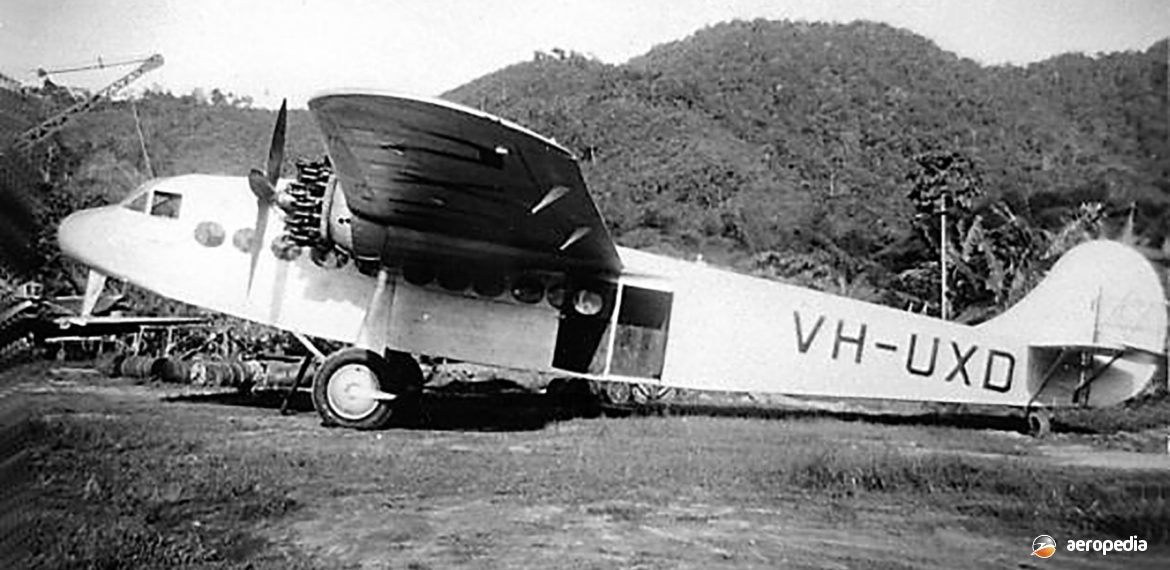Photograph:
Avro 642 VH-UXD (c/n 642) whilst operating at Salamaua in 1938 in New Guinea (James Sinclair)
Country of origin:
United Kingdom
Description:
Commercial airliner
Power Plant:
Two 343 kw (460 hp) Armstrong Siddeley Jaguar VID fourteen-cylinder two-row air-cooled radial engines
Specifications:
- Wingspan: 21.73 m (71 ft 3 in)
- Length: 16.63 m (54 ft 6 in)
- Height: 3.52 m (11 ft 6 in)
- Wing area: 67.63 m² (728 sq ft)
- Max speed: 257 km/h (160 mph)
- Cruising speed: 217 km/h (135 mph)
- Initial rate of climb: 296 m/min (970 ft/min)
- Ceiling: 4,724 m (15,500 ft)
- Range: 966 km (600 miles)
- Empty weight: 3,338 kg (7,360 lb)
- Loaded weight: 5,352 kg (11,800 lb)
History:
Originally known as the Avro Eighteen, the Avro 642/IIm was a twin-engine commercial transport using the wing of the Avro Ten but with both engines attached thereto and no engine in the nose. The Model 642 did not look much like earlier Avro aircraft, was much cleaner aerodynamically, and had a semi-circular glazed windscreen to the pilot’s compartment initially, this later being replaced by a conventional stepped windscreen. The prototype G-ACFV (c/n 642) was operated by Midland & Scottish Air Ferries Ltd (named ‘Marchioness of Londonderry’) from April 1934. A four-engine variant VT-AFM (c/n 773) was also built and named ‘Star of India’ but these were the only aircraft completed.
After Midland & Scottish Air Ferries Ltd ceased operations, the Model 642 was obtained by Commercial Air Hire Ltd at Croydon in Greater London, UK but soon thereafter, in 1936, it was sold to W R Carpenter & Co Ltd, arriving in Sydney, NSW in August 1936. W R Carpenter had extensive interests in shipping, trading and plantations in Papua New Guinea and required large aircraft to service these interests. One plan was to develop a New Guinea to Australia air service, an announcement being made that the service from Sydney to Salamaua would begin in June 1936.
The airline sought a twin-engine aircraft with a speed of 241 km/h (150 mph) with accommodation for four and wireless equipment. However, the newly formed Australian Civil Aviation Board would not license the service. The aircraft was purchased for £17,500 ($35,000) and was shipped to Sydney, assembled and flown to Papua New Guinea with R O Mant as pilot.
Australian registration VH-UXD (c/n 642) was allotted on 28 September that year and Avro 642 entered mail services in New Guinea. It became quite popular, being able to carry 16 passengers, or 2,032 kg (4,480 lb) of freight at 217 km/h (135 mph). Ownership was later transferred to Mandated Airlines Ltd of Salamaua of New Guinea on 8 April 1937, registration being transferred on 19 March 1937. It suffered some damage in June 1938 when the de Havilland DH.66 Giant Moth VH-UJB collided with it on the ground at Wau.
The Avro 642 aircraft was still in New Guinea when Japanese forces attacked and was unable to be evacuated. Together with a number of other aircraft, it was destroyed at Salamaua on 21 January 1942 by strafing Japanese fighters. The registration was cancelled on 11 March 1942.

